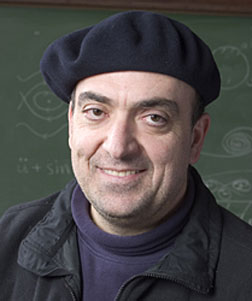- Number 384 |
- March 18, 2013
PNNL’s Karniadakis likes exploring new territory

Professor George Karniadakis
Professor George Karniadakis admits that it was the appeal of the unknown that attracted him to the field of mesoscopic modeling of materials. “It’s really the least explored area, in terms of math modeling,” he says. “And it’s a critical area because it affects molecular scale, a critical element in designing new smart materials.”
Karniadakis, a professor of Applied Mathematics at Brown University who has a joint appointment at DOE's Pacific Northwest National Laboratory, was also one of the first to focus on uncertainty quantification, which is now one of the fastest growing areas of modeling and simulation research. He is now turning his attention toward another emerging field, fractional differential equations, including organizing an international workshop that will be held later this year. “It’s totally unexplored,” he says. “That’s my favorite part – exploring new fields in math and engineering and being at the leading edge as these new horizons open.”
That’s the formula he’s followed since earning his Ph.D. more than 25 years ago. His path has included time at the Massachusetts Institute of Technology (his alma mater) and Princeton, as well as serving as a visiting professor at Caltech and Peking University, before he joined Brown in 1994.
Recently, his wealth of experience resulted in his being named the principal investigator for the new Collaboratory on Mathematics for Mesoscopic Modeling of Materials (CM4), a 5-year, $6 million project funded by DOE's Advanced Scientific Computing Resources program. The multi-organization collaboration is focusing on providing fundamental scientists with a new way of describing interactions of particles of matter at a very small scale. This new approach relies on developing rigorous mathematical foundations to understand and control basic mechanisms in mesoscale processes. To make this approach a reality, scientists are designing modeling methods and corresponding scalable algorithms.
“Our goal is to enable the design of new materials with properties that will ‘tune’ according to the needs of the problem,” Karniadakis says. “Currently, we’re not able to do that at the different scales that are needed by scientists.”
To achieve this, the project will focus on a number of approaches, including development of particle- and grid-based methods and concurrent coupling, coarse graining, and integration of these mathematical and computational tools for applications in scalable synthesis of materials.
“Our mission is to develop and disseminate this next generation of tools, and train the scientists who will use them,” says Karniadakis.
The team of two national laboratories and six universities includes researchers with a wide range of experience, which serves another of his passions – ensuring the next generation of researchers gets ample opportunities to participate in major projects and build experience.
Outside of the laboratory, Karniadakis says he likes to eat and enjoys good wines. One of the benefits of his association with PNNL is the proximity to Washington’s wine country. “Last time I was out there, I went on a wine tour, and was pleasantly surprised by the way that industry is flourishing.” He also likes playing tennis with his students, and is a fan of the Chinese culture, although he is himself a native of Greece.
“I love to travel – particularly anywhere in Europe and to China.” He and his wife – an assistant professor at Harvard Medical School – and their two children, ages 14 and 11, also make trips to Greece every three years.Submitted by DOE's Pacific Northwest National Laboratory
